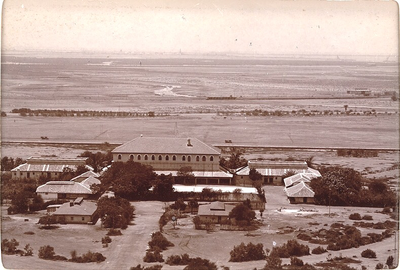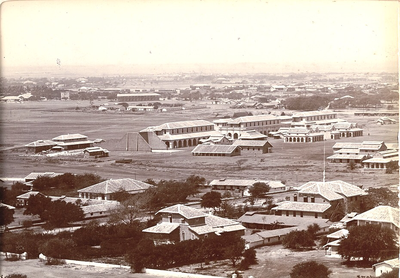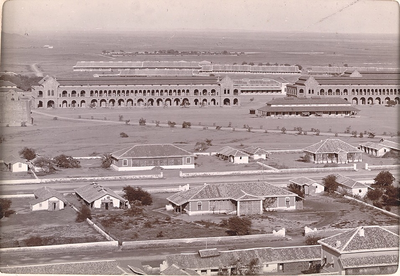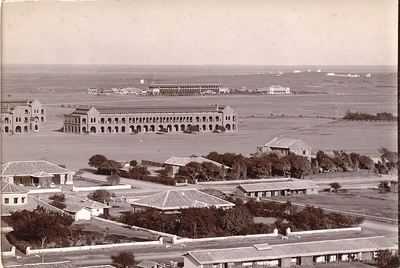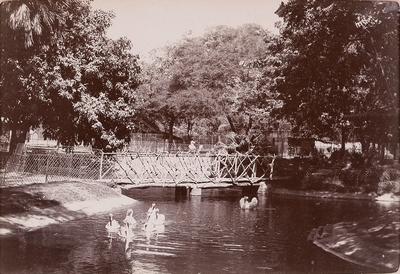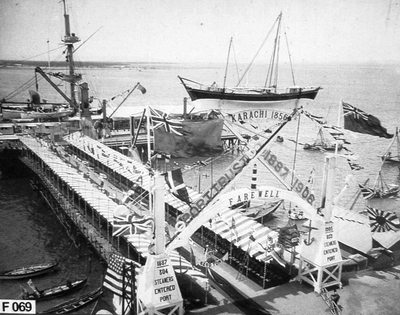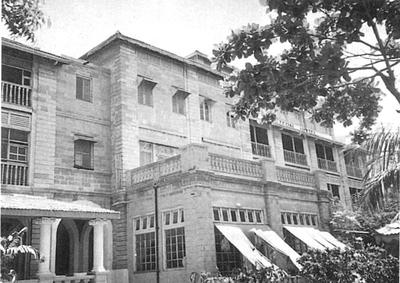TURN OF THE CENTURY - 1900's
In 1838, Karachi had had about 14,000 inhabitants. This number had risen to 56,000 by 1872, and kept on growing. By 1891, statistics showed a population of about 105,000 and by the time the 19th century drew to a close, Karachi had 117,000 inhabitants as of 1901. Karachi had become one of the biggest and best outfitted ports of the world. The population of the city had crossed over a hundred thousand of which, 55 percent were Muslims and 41 percent were Hindus. Karachi was now a city with a metropolitan character attracting sizable populations of European traders, Iranians, Lebanese, Goan, Parsi and Hindu merchants. Among these, the Parsi merchants quickly made a good reputation for themselves and rose to a prominent position in the city. They made significant contributions to the growth of the city through their generous philanthropy.
The bustling city also had a traffic problem. Because of the number of carts and carriages on the streets, the roads had to be paved with gravel chippings (which was a refinement ahead of its time even before London). Municipal bullock carts used to water the city streets daily to keep the dust from flying around. Carriage horses wore straw hats to avoid sunstroke and were provided drinking water from troughs placed at various locations in the city by the philanthropic "Drinking Trough Society of Karachi". In 1900, a public tram service was introduced which commenced from Sadder cantonment and went up to the harbour at Kiamari.
The bustling city also had a traffic problem. Because of the number of carts and carriages on the streets, the roads had to be paved with gravel chippings (which was a refinement ahead of its time even before London). Municipal bullock carts used to water the city streets daily to keep the dust from flying around. Carriage horses wore straw hats to avoid sunstroke and were provided drinking water from troughs placed at various locations in the city by the philanthropic "Drinking Trough Society of Karachi". In 1900, a public tram service was introduced which commenced from Sadder cantonment and went up to the harbour at Kiamari.
The following is a remarkable series of photographs taken by an unknown photographer from the tower of the Trinity Church, showing a full 360 degree view of what Karachi looked like in the 1900s.
Looking towards Saddar and the main central part of town (left to right =NW to NE). Note the green area behind the city are the gardens surrounding the Lyari river.
Looking towards Bundar Rd (now M. A. Jinnah Rd.) and the portside (Left to right = SW to NW). The first picture shows the Government House which was built in the 1840s by Charles Napier, the British general and first governor of Sindh (1843-47). Originally, it was a single storey building, the upper storey being added by John Jacob in 1856-57. Set in 40 acres of gardens overgrown with oleanders and tamarisks, the house was approached along an impressive driveway which led from Victoria Road.
In the nest two pictures is the Artillery ground and associated buildings. The main city area on Bundar Road would be in the background, but is out of range of these photos.
In the nest two pictures is the Artillery ground and associated buildings. The main city area on Bundar Road would be in the background, but is out of range of these photos.
Looking towards Clifton and Frere Hall (left to right = SE to SW):
The Convent and the Cantonment (left to right = NE to SE): The second and third pictures are dominated by the Napier Barracks. These barracks were built by Charles Napier, the first governor of Sindh (1843-1847). They are constructed of the local buff Gizri stone. The main building faced the prevailing breeze and the deep arcaded verandahs and high ceilings were intended to make the interior as cool as possible.
|
Karachi now had a tram system to tackle the growing Traffic problem in the city. See below link for more pictures and history of this tramway.
|
"Sadr Bazaars were permanent markets which existed all over the sub-continent, they were developed by British forces in the towns they occupied to facilitate the provision of supplies to the troops in the cantonments. The Saddar Bazaar at Karachi followed a typical gridiron plan; all the major north-south streets of the Bazaar were laid out at right angles to Bunder Road, Frere, Somerset and Elphinstone Streets which along with Victoria Road, linked the northern part of the cantonment to the southern part. The area soon developed into the most fashionable part of the city, supplying the needs of both civilians and military personnel."
Courtesy: British Library www.bl.uk
Courtesy: British Library www.bl.uk
Government Gardens Karachi
|
The Government Gardens - currently the site of the Karachi Zoo were located near the banks of the Lyari river and were made possible because of the water from this river.
"The gardens were designed by Major Blenkins and originally intended to supply British troops stationed in Karachi with fresh vegetables. As well as many varieties of fruit and vegetables a large vineyard was situated here providing good quality grapes. The zoo was started by Strachan and Ffinch, the director of the Indo-European Telegraph." Courtesy: British Library www.bl.uk |
Karachi Harbour Works
The Karachi Port had become well established by now. Kiamari served as the landing place for all goods and passengers bound for the city of Karachi. Traffic was conveyed by the East India Tramway over a 3 mile long road running along the ‘Napier Mole’.
The Parsi Contribution
Karachi had a large community of Zoroastrians which were locally known as Parsis. The Parsis were and continue to be a vibrant business community that made many institutions of the city that contributed to its development. They were also generous philanthropists who donated generously towards making better recreational and civic areas for the city. Some of their contributions to the city during its formative phase have left their strong mark even today.





